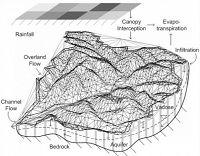tRIBS
tRIBS Model
tRIBS (TIN-based Real-Time Integrated Basin Simulator) is a fully distributed physically-based hydrologic model.
Model Category: Numerical
Image: tRIBS (TIN-based Real-Time Integrated Basin Simulator)
-
Calhoun, Luquillo, INVESTIGATOR
tRIBS (TIN-based Real-Time Integrated Basin Simulator) is a fully distributed physically-based hydrologic model developed by the Bras Group at the Massachusetts Institute of Technology (Ivanov et al., 2004). A Vegetation Generator for Interactive Evolution (VEGGIE) model was coupled with tRIBS. tRIBS+VEGGIE (Ivanov et al., 2008a,b; Sivandran and Bras, 2012; Lepore et al. 2013) explicitly accounts for the spatial variability in precipitation fields, vegetation, soil moisture and topography to simulate different components of the hydrological cycle. The model is capable of a sophisticated description of several ecohydrological processes including plant physiology and spatial dynamics over the complex topography of a river basin. It uses voronoi polygons as basic computational units. More recently, a geomorphic module was developed within tRIBS to model sedimentation mechanisms by simulating main hillslope and channel erosive processes (Francipane et al., 2013). Landscape evolution feedbacks to hydrological dynamics through local changes of slope, aspect, and drainage network configuration.
References
Francipane, A., Ivanov, V. Y., Noto, L. V., Istanbulluoglu, E., Arnone, E., & Bras, R. L. (2012). tRIBS-Erosion: A parsimonious physically-based model for studying catchment hydro-geomorphic response. Catena, 92, 216-231.
Ivanov, V. Y., Vivoni, E. R., Bras, R. L., & Entekhabi, D. (2004). Catchment hydrologic response with a fully distributed triangulated irregular network model.Water Resources Research, 40(11).
Ivanov, V. Y., Bras, R. L., & Vivoni, E. R. (2008a). Vegetation‐hydrology dynamics in complex terrain of semiarid areas: 1. A mechanistic approach to modeling dynamic feedbacks. Water Resources Research, 44(3).
Ivanov, V. Y., Bras, R. L., & Vivoni, E. R. (2008b). Vegetation‐hydrology dynamics in complex terrain of semiarid areas: 2. Energy‐water controls of vegetation spatiotemporal dynamics and topographic niches of favorability. Water Resources Research, 44(3).
Lepore, C., Arnone, E., Noto, L. V., Sivandran, G., & Bras, R. L. (2013). Physically based modeling of rainfall-triggered landslides: a case study in the Luquillo forest, Puerto Rico. Hydrology & Earth System Sciences, 17(9).
Sivandran, G., & Bras, R. L. (2012). Identifying the optimal spatially and temporally invariant root distribution for a semiarid environment. Water Resources Research, 48(12).
Explore Further


